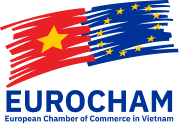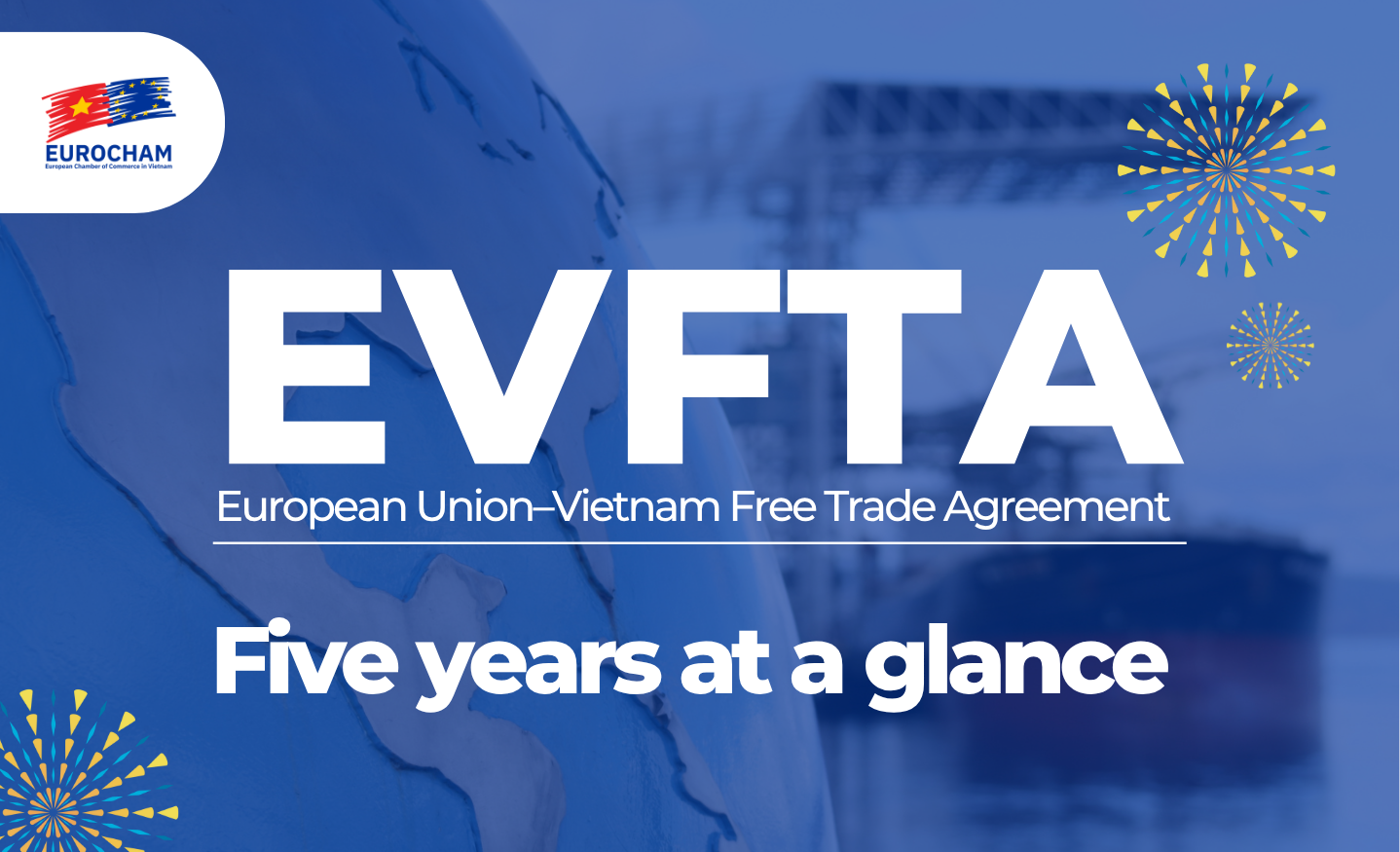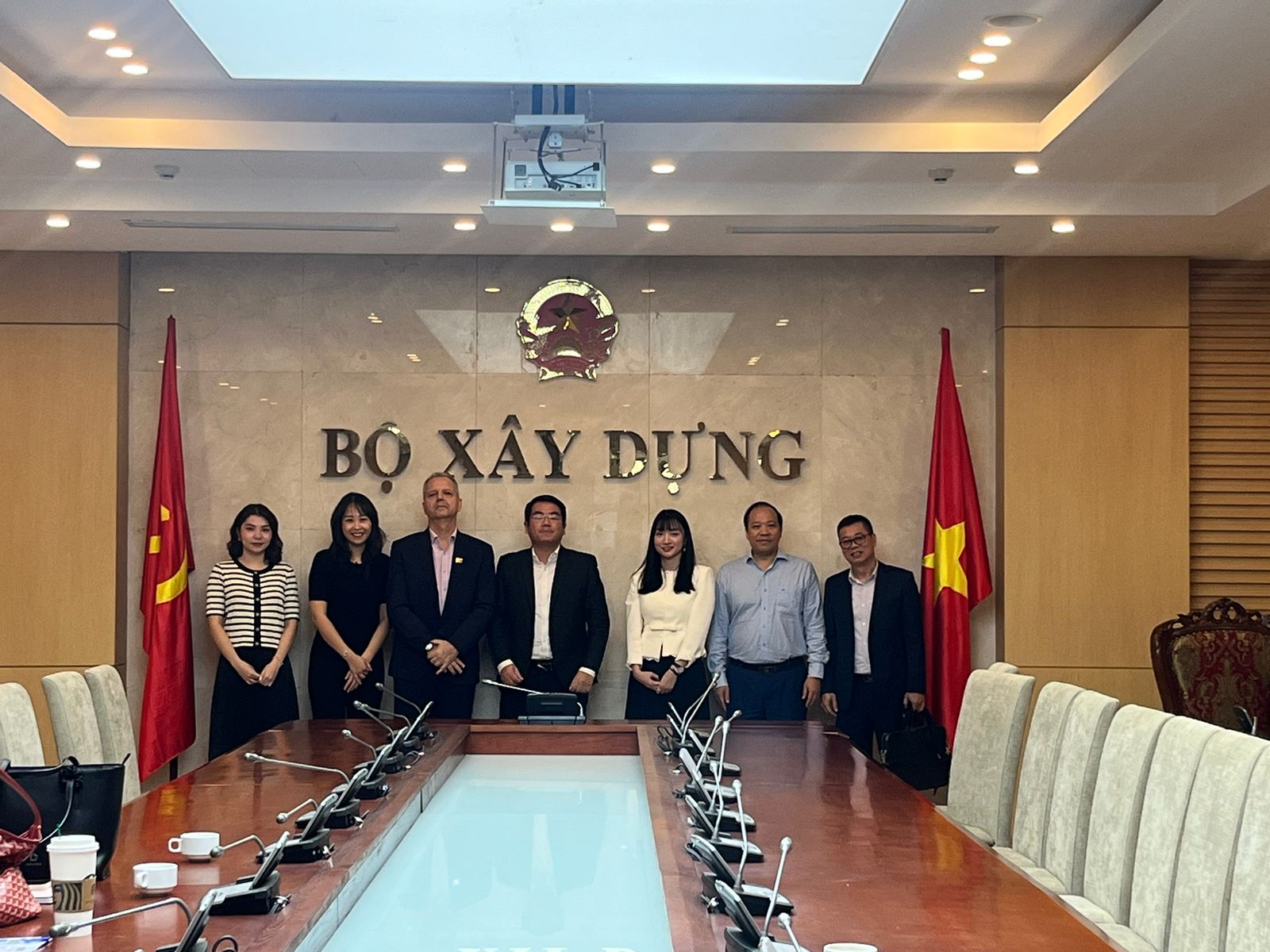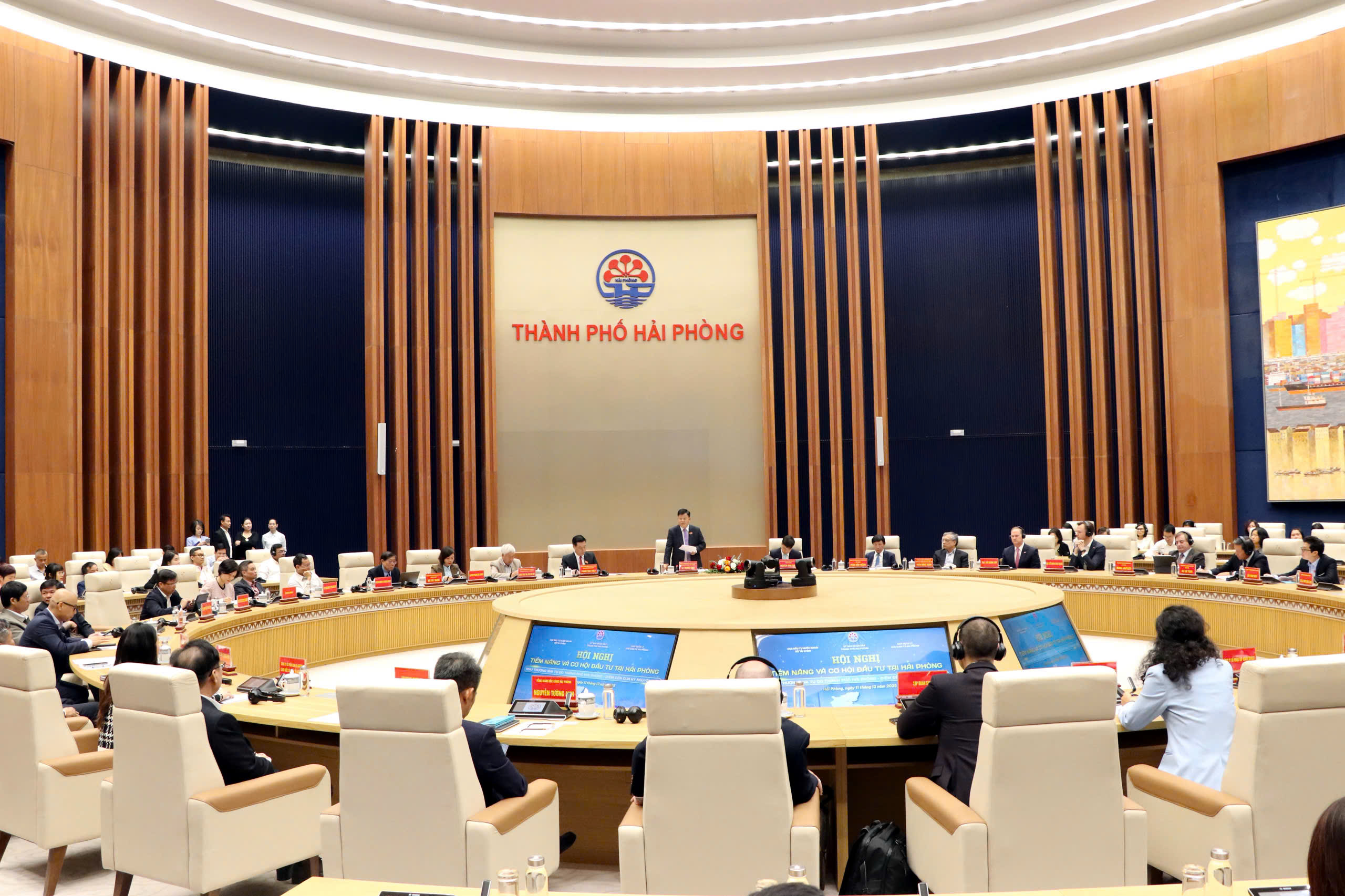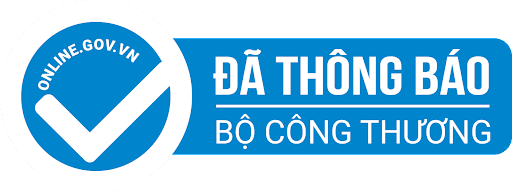Five years since its entry into force, the EU-Vietnam Free Trade Agreement (EVFTA) has catalysed nearly $300 billion in two-way trade, establishing Vietnam as the EU’s top trading partner in ASEAN and its 16th largest globally. In an era marked by rising global tensions and trade fragmentation, the EVFTA stands as a testament to inclusive, rules-based cooperation – one rooted in shared values, sustainability, and long-term strategic alignment.
From the earliest days of negotiation, the European Chamber of Commerce in Vietnam (EuroCham) has stood alongside both the European Union and the Government of Vietnam, advocating for an agreement that is both ambitious and practical. Today, EuroCham continues to champion the EVFTA’s core values: promoting fair trade, driving business growth, shaping forward-looking policies, and bridging stakeholders across Vietnam and Europe.
Click here to explore EVFTA’s impact by the numbers.
Tham khảo Thông cáo Báo chí tiếng Việt tại đây.
Trade gains and business impacts
Signed on 30 June 2019 and entering into force on 1 August 2020, the EVFTA is one of the EU’s most comprehensive and ambitious trade agreements with a developing nation. It has already eliminated over 70% of tariffs on various goods, with the remaining reductions – up to 99% – to be phased in over the coming years. Beyond tariff liberalisation, the agreement also improves market access, strengthens intellectual property protection, and enhances regulatory transparency.
It also fosters the long-term alignment of values and standards – a point EuroCham Chairman Bruno Jaspaert highlights as central to the agreement’s success: “In today’s climate of mounting geopolitical uncertainty and unilateral tariffs, the EVFTA stands as a beacon of trust and cooperation. This year, 1 August not only marks the EVFTA’s fifth anniversary but also a pivotal moment in the global trade landscape.
“As the world turns its attention to the fine print of new trade deals and the real enforcement of ‘reciprocal tariffs’ from the US, the EVFTA offers clarity and certainty. Its detailed provisions and mutual commitments between Vietnam and the EU show that aligned standards and open markets can deliver concrete growth and shared prosperity.”
In fact, since its implementation, EU-Vietnam trade has grown significantly. Preliminary data from Vietnam’s National Statistics Office shows that EU-Vietnam two-way trade reached $298 billion between August 2020 and May 2025 alone. This five-year figure accounts for nearly 40% of the $815 billion in cumulative trade recorded over 30 years of economic and trade cooperation since 1995 – a powerful proof of the EVFTA’s catalytic impact.
Vietnam now leads first in ASEAN and 16th in the world for goods trade with the EU, exporting everything from electronics and textiles to furniture and agri-food products. In return, Europe is Vietnam’s third largest exporting destination and fourth largest source of imports, supplying high-tech machinery, vehicles, pharmaceuticals, and green technologies.
The latest EuroCham’s Business Confidence Index (BCI) in Q2 2025 shows that 66% of surveyed businesses are actively involved in EU-Vietnam trade, and almost all (98.2%) are aware of the EVFTA. Half reported moderate to significant benefits from the agreement – a number expected to rise further as more tariff reductions take full effect.
Importantly, it is not just large corporations reaping the rewards – small and medium-sized enterprises (SMEs) are also reporting benefits from the agreement. The proportion of businesses citing tariff reductions as a key advantage surged from 29% in Q2 2024 to 61% in Q2 2025. Among those able to quantify their gains from the EVFTA, the average boost to the bottom line was 8.7%, with top-performing firms reporting increases of up to 25%.
Seizing opportunities and managing frictions
Beyond tariff reductions, the EVFTA has opened new doors for European businesses to tap into Vietnam’s rapidly growing domestic market – from public-private partnerships to incentivised foreign direct investment. With a population of 100 million, including a 55-million-strong workforce, Vietnam offers European firms wide-ranging opportunities for deeper supply chain integration and long-term market expansion.
In sectors such as sustainable agriculture, digitalisation, and green energy, European expertise complements Vietnam’s resource base and development priorities. For instance, European innovations in digitalised, sustainable farming are enhancing productivity and quality across Vietnam’s agri-food and aquaculture sectors – areas where Vietnam remains a vital supplier to the European market. At the same time, the EVFTA positions Vietnam as a reliable alternative hub in an increasingly disrupted global trade environment.
On the other side of the equation, the EU remains a highly attractive destination for Vietnamese exporters. With a combined GDP of $29 trillion (in purchasing power parity terms) and a population of over 450 million consumers, the EU is the world’s largest single market. Governed by transparent rules and predictable regulations, it offers a GDP per capita of more than $43,000 – according to a World Bank report in 2024 – making it a premium market for high-quality Vietnamese goods.
Yet even as benefits grow, challenges persist. Nearly 37% of surveyed firms reported customs valuation discrepancies, while others cited unclear regulations, inconsistent enforcement, and lack of alignment between EU and Vietnamese authorities. These frictions limit the full potential of the agreement.
EuroCham Vice-Chair in charge of advocacy – Jean-Jacques Bouflet – who was among EU’s lead negotiators for the EVFTA, reflects on the evolving nature of the agreement: “When we negotiated the EVFTA, every clause was designed to ensure both productivity and integrity. We anticipated complexity and worked hard to strike the right balance. But implementation is always a journey. It requires continual adjustment, constructive discussions, and a business-focused mindset.”
Navigating trade diplomacy with origin stories
One such area of ongoing complexity is the Rules of Origin. While central to securing tariff preferences, they remain difficult to apply in practice. Many Vietnamese exports rely on raw materials from third countries, making it difficult to meet origin criteria. Although the cumulation rule allows inputs from certain partner countries, complicated documentation and fragmented supply chains often hinder compliance.
Vice-Chair Bouflet contends: “At this point in time, the precise definition of the new requirements imposed by the U.S. on so-called ‘transhipped’ goods remains unclear. This uncertainty could severely affect established Rules of Origin, especially when imported inputs are incorporated into Vietnamese-manufactured products. That is why EuroCham continues to advocate for further lifting of technical and non-technical trade barriers, clearer guidance on HS codes and customs valuation, as well as cross-referencing frameworks within and between customs authorities.
“These measures are essential to safeguard supply chain resilience and ensure businesses can move forward with confidence. More broadly, they highlight the importance of economies upholding shared values and honouring existing FTA commitments – agreements that have already delivered tangible results and require continued dialogue to reach their full potential, particularly in today’s increasingly complex global trade environment.”
In this context, Certificates of Origin (C/O) have become indispensable tools for businesses navigating global trade. Today, 56% of EuroCham BCI respondents submit C/O documents monthly. A growing number also cite them as critical for ensuring compliance, gaining preferential treatment, and building trust in end markets.
In 2024 alone, Vietnam issued 1.8 million preferential C/O, worth over $100 billion. This marks an 18% increase in volume and a 28% rise in value compared to 2023, accounting for 28% of Vietnam’s total export turnover to FTA-partner markets. Notably, in the same year, Vietnam’s exports to the EU reached a record-breaking $51.7 billion – an impressive 18.4% year-on-year growth, underscoring the EVFTA’s rising uptake.
After centralising the C/O issuance process in May 2025, Vietnam is now planning for a national digital platform to further ease trade flows. While a small share of businesses already receives certificates in under 24 hours, others still face wait times exceeding a week – tying up capital and delaying shipments.
In response, European businesses call for clearer and simplified procedures such as mechanisms for e-registration and self-certification – steps that can reduce bottlenecks and boost confidence in the EVFTA’s long-term impact.
Advancing reforms through trusted partnership
EuroCham welcomes Vietnam’s ambitious reform agenda to modernise the economy and boost efficiency. Since late 2024, the Government has launched bold structural changes, including ministerial consolidations, provincial mergers, and a 30% cut of the state apparatus.
The rollout of Enterprise VNeID and the launch of the country’s first FTA Index in 2025 are critical steps toward digital governance and evidence-based policymaking.
Developed by the Ministry of Industry and Trade in collaboration with relevant ministries and agencies, the FTA Index offers transparent, objective metrics to help central and local authorities guide, monitor, and manage economic integration. It also lays a foundation for policy formulation and local development strategies, reinforcing sustainable export growth.
Vietnamese leaders have consistently recognised both the opportunities and challenges of global integration, stressing the importance of flexible, timely, and effective responses. Maximising the benefits of FTAs is a key strategy for sustaining growth and advancing Vietnam’s global standing.
“As a someone who has built businesses and help other investors find their niche in Vietnam as a second home, I understand the frustrations when administrative bottlenecks slow down investment projects,” said Chairman Jaspaert. “But I also see something else: a government that listens, engages, and takes real steps toward change. At EuroCham, we have seen this drive to improve firsthand. All economic metrics show that the era of rising – of growth and development aspired to by General Party Secretary Tô Lâm – has arrived. Now, more than ever, it is time to double down on promised reforms and turn dialogue into delivery.”
As its founding mission, EuroCham has always maintained close dialogue with Vietnamese and European authorities to serve as a bridge between the public and private sectors. In Q1 2025 alone, EuroCham led sectoral delegations, held high-level discussions with Prime Minister Phạm Minh Chính, and spotlighted Vietnam’s reform momentum to the attention of EU policymakers through our annual Brussels mission.
Chairman Jaspaert emphasises:“The EU remains one of Vietnam’s strongest and most stable economic partners. If we join forces, eliminate roadblocks, and stay focused on execution, the EVFTA can show the world once more that mutual trade deals do work – and deliver win-win outcomes for both parties. EuroCham and the European business community are here to support Vietnam through this pivotal chapter. We are here to stay and to help this country achieve its long-term growth ambitions.”
Gateway to deeper EU-Vietnam relations
According to the World Trade Organization, there are now 328 FTAs in force globally, compared to just 98 in 2000. Vietnam has signed 17 FTAs, positioning itself at the heart of regional and global trade networks.
As we celebrate both five years of EVFTA and 35 years of EU-Vietnam diplomatic relations, the focus now shifts toward deepening and future-proofing this partnership. The EU-Vietnam Investment Protection Agreement (EVIPA) is still pending ratification by a few remaining EU member states – but once fully in force, it will provide a critical legal framework to protect and encourage long-term European investments in Vietnam.
Momentum is also building toward a Comprehensive Strategic Partnership – a natural next step for two partners increasingly aligned on trade, sustainability, and global governance.
“Five years in, the EVFTA is proof that real partnership works,” said EU Ambassador Julien Guerrier. “It has strengthened trust, encouraged trade, and brought tangible benefits to both sides. Of course, the global trade environment is evolving – but that only makes our continued cooperation more important. The EU remains firmly committed to working with Vietnam toward a green, resilient, and prosperous future.”
As EuroCham’s 2025 Whitebook stresses, progress must be institutionalised. Deeper cooperation will require further progress on customs alignment, streamlined procedures, regulatory consistency, and fair enforcement. Effective EVFTA implementation is more than meeting treaty obligations – it is a catalyst for broader reform, market expansion, and long-term resilience.
###
About EuroCham Vietnam
Founded in 1998, the European Chamber of Commerce in Vietnam (EuroCham) has established itself as the unified voice of the European business community in Vietnam. With offices in Hanoi and Ho Chi Minh City, we represent a diverse spectrum of companies, ranging from small and medium-sized enterprises to multinational corporations. EuroCham plays a crucial role in shaping policy dialogues, fostering bilateral trade and investment, and fortifying economic ties between Europe and Vietnam, particularly within the framework of the EU-Vietnam Free Trade Agreement (EVFTA).
EuroCham Vietnam boasts a substantial membership base comprising over 1,400 companies, solidifying its position as one of the largest foreign chambers operating in Vietnam. We function as the “chamber of chambers,” encompassing nine prominent national European business associations in Vietnam, which include:
EuroCham’s diversified influence is underpinned by our extensive network of 19 specialised Sector Committees. Serving as think tanks within their respective industries, these committees provide invaluable expertise, steer policy recommendations, and stimulate industry-specific dialogues. This organisational framework guarantees that the concerns and viewpoints of diverse sectors are actively considered, thereby moulding EuroCham’s cross-sectoral agenda and magnifying its overall influence.
For more information about EuroCham, visit: www.eurochamvn.org.
For media enquiries, please contact:
EuroCham Vietnam Media & Communications Officer
Ms. Tram Hoang – tram.hoang@eurochamvn.org
